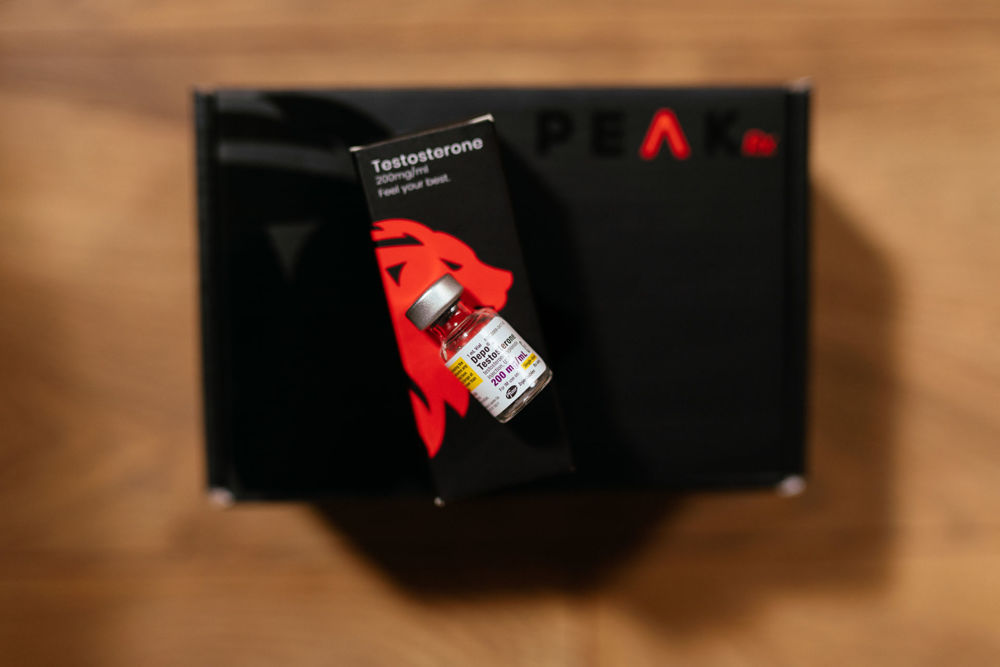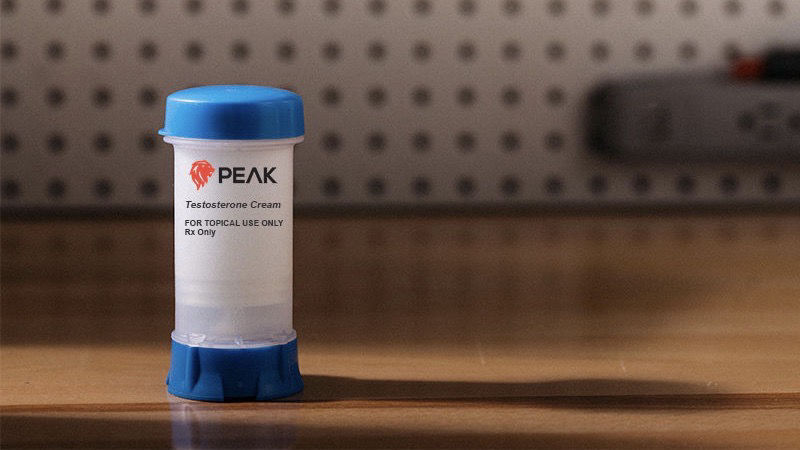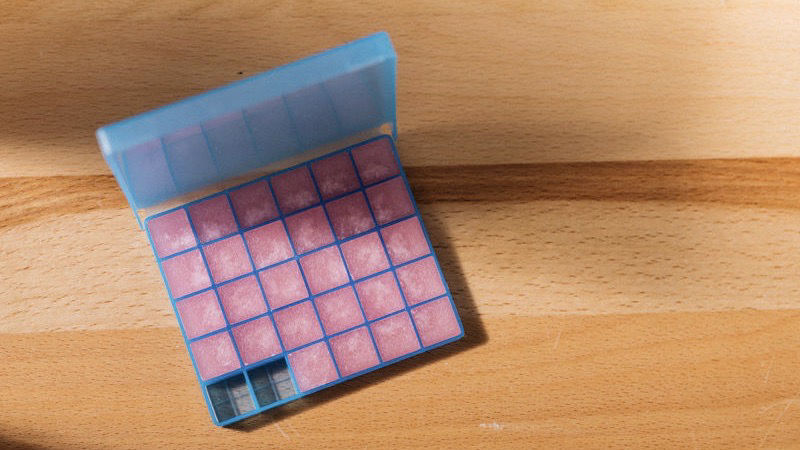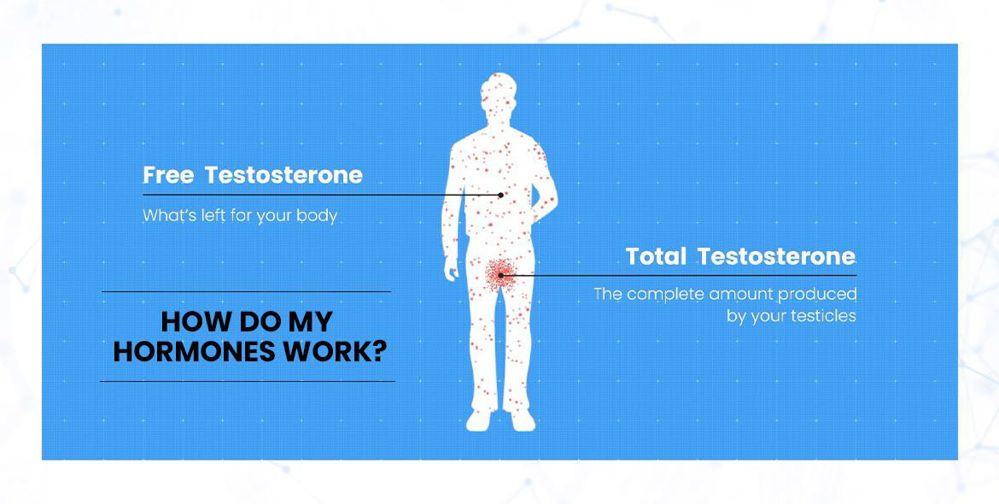
First, a disclaimer: The opening paragraphs may come off as a bit of a downer. Don’t worry, it gets better. (Well, I think it does, since I wrote this.)
When your testosterone is low, all of you is “low” – energy, mood, stamina, everything. Regardless of diet and exercise, your midsection’s starting to resemble the Pillsbury Doughboy’s, and there’s nothing ticklish about that. Everything just “feels” like crap – everyday activity, work productivity, relationships…you name it. It’s especially bad in the ways of amore. You’re having a hard time keeping up your end of the bargain romantically, and because your sex drive is MIA, it’s making you as a man feel likewise.
More than one out of four men aged 30 and over are going through this state, this funk, this persistent, craptacular malaise that makes you feel even crappier for feeling it at all. Welcome to Hypogonadism – aka clinically significant hormone deficiency, aka low testosterone. Population: You.
Sadly, to date there has been little study of this genuine and growing issue. And, unlike certain other things, it is growing – today’s average 30-year-old male possesses approximately 17 percent less testosterone than a 30-year-old man at the start of the 21st century. A number of variables are attributable, but the end result remains consistent.
Okay, we’ve spelled out the worst of it. Let’s head toward a more optimistic route, shall we?
There’s no longer any need to carry around that mental “The End Is Near” billboard. Yes, the studies have been lacking, but the medical community more widely recognizes “Low T" today. More important, said community and numerous companies have started tackling the problem head-on with testosterone replacement therapy (TRT). And at the forefront among them is Peak.
When CEO Saad Alam co-founded the telemedicine service, he wanted a platform that was laser-focused on hormone testing and optimization solutions. His ambition was born out of personal experience. At the age of 35, Alam – a self-described enthusiast of all things related to fitness and wellbeing – experienced dramatic declines to his body mass, energy, focus, overall mood and drive. After multiple, fruitless conversations with medical professionals, Alam pinpointed his problem with the help of a hormone optimization specialist. The diagnosis? He had the testosterone levels of an 80-year-old man. Once he began treatment, Alam resharpened his mindset and focus, regained his lost energy and drive, and found a new purpose: To help others in situations similar to his own, and to remove long-perceived stigmas regarding Low T.

Enter Peak, and into your home no less. The company’s platform enables you to register for an at-home hormone testing kit that’s mailed to your house and includes the items necessary for successful measurement. Take the test as instructed (it's very simple and pain-free) and mail your blood sample in a prepaid envelope to a lab that’s CLIA (Clinical Laboratory Improvement Amendments) or CAP (College of American Pathologists) accredited. Once the lab tests your samples and provides the results, a telemedical call is set up with one of Peak’s network of certified physicians. There, the doctor reviews your results with you, discusses how you’re feeling and prescribes a treatment plan that’s customized to your specific clinical needs.
That last part is very important. You’re not given some by-the-numbers medical treatment that’s mass-prescribed for all patients with similar levels. This is specialized, individual care – the right way to go since you, being an individual, are going to respond to treatment different than anyone else.
Peak opened its figurative doors in March 2020, a time when countless businesses closed their entrances amid a global pandemic. One might think there are bound to be some procedural hiccups along the way. However, the service is incredibly efficient, effective and affordable. Here’s how everything breaks down:
• Get your result, schedule your consult
• The doctor is (virtually) in
• A great way to treat yourself
Yes, homework sucks. It sucked when we were kids in school, it sucks now. Thankfully, this form of virtual learning is easy-peasy-lemon-squeezy, and it’s going to help you ace your health and wellbeing.

Your homework assignment consists of the following:
• Order your at-home hormone testing kit on Peak’s website, fill out the required fields (first name, last name, email address and state) and purchase your kit at checkout. It’s not unlike enrolling for a class and picking up school supplies before the first day.
• Register your kit. If you don’t, the wheels on this bus don’t go round and round.
• Fast 10 to 12 hours before testing (drink all the water you want)
• Get a good night’s sleep, as much as possible (As someone who slept through much of his college philosophy class, I can attest that it’s more comfortable sacking out in a bed.)
• The next morning, organize your kit’s contents on a clean, flat surface. Contents include a specimen bag, non-adherent pads, alcohol pads, lancets, ADX blood collection cards and a blood samples return bag.
• Get your blood flow moving beforehand. Wash your hands with warm water, drink a glass of water and do something active, like running in place. (Think Flashdance and Jennifer Beals capering to “Maniac.” Nix the bucket of water overhead.)
• Use the lancet on the fleshy part of your ring finger and let the droplets of blood fill only the recommended field on each collection card. You may need to do this twice, but it really is an easy, painless process.
• Let the blood dry on the cards for about an hour, then place your samples inside the return bag; put the return bag inside the prepaid envelope that goes to the lab
• Have the government do the rest; give the U.S. Postal Service some mail to deliver
• Important: Complete your test before 10 a.m., when your testosterone levels are at their optimum for the day
When it’s time to take your test, you can refer to these pearls of prose or just follow the much easier video tutorial that Peak provides via a QR code on the kit’s inside lid (and on Peak’s website). The video is so direct, simple and effective, you’ll almost question why this method isn’t utilized for more remote testing.
From the onset, Peak leaves no stone unturned. Once the lab receives your kit, your blood is comprehensively tested for the following:
• Free Testosterone: This form of unattached testosterone is the hormonal equivalent of “that guy” – bioavailable, not looking for a commitment with any proteins, but still wants to be productive friends with them.
• Total Testosterone: This is the one-two punch of free testosterone and testosterone that’s bound primarily to albumin and sex hormone binding globulin (SHGB).
• Luteinizing Hormone (LH): Produced by the pituitary gland located beneath your brain, this gonadotropin is your body’s idea of a hotshot Hollywood director/writer/producer. LH directs its secretion into the testes, which in turn creates testosterone that produces sperm. If any of those levels falter, don’t expect your member to enjoy a boffo box-office weekend.
• Estradiol: Here’s your go-to, predominant form of estrogen, modulating your libido, erectile function and spermatogenesis. Of your body’s three estrogens, this one’s up there on the level of Marvin Gaye or Barry White.
• Sex-Hormone Binding Globulin (SHBG): This protein gets it on with your estrogen, dihydrotestosterone (DHT) and testosterone levels. It also controls the amount of testosterone your body tissue uses. If your liver has a tie on the doorknob, don’t come a-knockin’.
• Albumin: Here’s a liver-produced powerhouse that accounts for about 60 percent of the total protein in your blood, sustains tissue, and transports hormones, vitamins and nutrients throughout your body. Show mad respect for albumin.
• Alanine Aminotransferase (ALT): Your body uses this enzyme to convert food into energy and is found primarily in your liver, though small amounts can be found hanging about in your kidneys.
• Aspartate Transaminase (AST): Another amino acid-metabolizing enzyme that’s produced in your liver, AST is also found in your heart, skeletal muscle, kidneys, brain, pancreas and lungs. Plus – and one cannot emphasize this enough to those of you with spellcheck on your computer – it’s “aspartate,” not the non-saccharine sweetener “aspartame.”
Once the lab receives your blood sample, your results will be made available on your Peak platform account within five days. If for any reason the lab is unable to process your blood work, you will be notified and a new Peak testing kit will be mailed to you at no charge.
Okay, so how much? Honestly, the cost can’t be beat – $45 for an at-home hormone testing kit and a video consultation with a Peak physician. You could be looking at anywhere from three to seven times that price, plus out-of-pocket expenses traveling to a specialist’s office and having these tests done in a local lab.
For transparency, at this time Peak’s services are not available through insurance. To be fair, the insurances that do cover such services are few and far between, and Peak’s pricing is comparable to many of their co-pays. Plus, Peak accepts Health Savings Account (HSA) and Flexible Spending Account (FSA) cards, which can add up to being a huge, pre-taxed advantage that keeps your out-of-pocket expenses minimal.
Say you don’t need the test kit because you’re already on testosterone replacement therapy on you had blood work recently done. You’re in luck – just provide Peak with a copy of your original lab results, plus a copy of recent blood work that’s no more than three months old. Those results must include measurements for the aforementioned hormone levels that Peak’s kit tests for. Should the doctor recommend against treatment, you will be refunded minus the cost of consultation.
Get your result, schedule your consult
All right, the lab has sent back the results from your blood sample collection. Now you can schedule a consultation with a Peak physician. Thankfully, it’s a far more accommodating process than making an in-person appointment with a physician, which often times can take weeks, if not months, to book. (Because, y’know, I always know exactly when I’ll require medical treatment. Jeez…)

Just log in at app.getpeaktoday.com, then click on the top left hamburger menu. (Those three stacked, red bars, for the uninitiated.) Inside the menu window, click on “Consultations.” A dropdown menu appears, giving you an option to self-schedule an initial consultation. (There’s also an option for consultation follow-ups). All available providers within your location and their timeslot availabilities will appear on your page, which also displays your Consultation History, listing up to 20 of your most recent sessions.
Now, it’s possible that you won’t see a list of available times, or there are no times listed that work with your schedule. There’s no need for concern. Just email support@getpeaktoday.com and notify them of your scheduling dilemma. You’ll be placed on a notification list for new availability. You and most patients are seen within a week of notifying Peak.
In addition to scheduling your visits, Peak’s platform allows you to review your files as needed, and your consultation with the physician takes place from the actual platform. Wait – you mean I don’t have to load a half dozen apps onto my mobile device and figure out each one about five minutes before my consultation? I’m in. I’m so in.
Important reminder moment: If you haven’t registered your kit, or the results from either your at-home test kit or your own blood work are not yet provided, you cannot access Peak’s platform. The platform only becomes available to you once your results are sent to you.
It’s time to talk with your Peak physician. Let’s first point out that, as much as we admire and respect them, these aren’t N.P’s or medical staff that are training to become doctors. These are bona fide, board-certified physicians boasting degrees from the likes of Brown, Dartmouth, Harvard and other universities I couldn’t get into. (Sorry, Mom.) They specialize in endocrinology, urology, internal medicine and hormone replacement therapy, so they’re best suited to diagnose and treat your levels. Think about it this way: Would you go to a plumber to fix your home’s electrical wiring? Of course you wouldn’t.
On average, a consultation runs around 30 minutes. Use it. If you’ve had questions about your Low T and how to treat it, write them down before your consultation so you’ll remember to ask them. Don’t worry if you’re asking something the physician may have heard a million times before; it’s more or less your first time discussing this, and you’re the one being cared for.
The physician will go over a lot of details with you. You might even feel a bit overwhelmed processing the information you’re hearing. That’s fine. Just ask the doctor to repeat the information, or simply wait for the more detailed diagnosis at the conclusion of your consult. Thirty minutes is a healthy amount of time for both of you to ask and answer questions, discuss treatment options, and identify the pros and cons for each treatment (physical and mental benefits, potential side effects, etc.).

Your first appointment with the physician, in which they’ll review your results with you, is done via a telemedicine video conference. Following that initial conversation, you can communicate with the doctor via video, call or chat, the latter two of those options being ideal if you have a quick question or they need to notify you of anything additional.
In a technology-driven world where personal privacy is increasingly difficult to maintain, it’s important to know that Peak’s telehealth platform is fully compliant with HIPAA – the Health Insurance Portability and Accountability Act. This is a federal law that protects sensitive patient health information from being disclosed without the patient’s consent or knowledge. In plain English: Your consultation with the doctor is like those Las Vegas ads – what happens in that consultation, stays in that consultation. Your privacy is assured.
Though consultations with Peak physicians are almost always conducted through telemedicine, there may be an instance when a doctor, in the interest of optimizing a safe treatment plan, will recommend an in-person visit or request additional blood work. On such occasions, Peak will coordinate with you in scheduling a visit to your home or having the additional testing delivered to you. Simply stated, the process is a little more complicated than you anticipated, but Peak is jumping through most of those hoops to keep it simple for you.
At this time, Peak’s services are currently available in 35 states. If you’re one of those unlucky territories, Peak advises that you enter your name, email and state on the page where you can order the at-home kit, click on the “Continue” button and you’ll be registered as a resident of that state. When the company’s services expand to your territory, you will receive an email to inform you that Peak’s services are available.
Let’s be honest: Testosterone replacement therapy is not some mythical spring you bathe in to restore your lost youth. Sorry, fellas, you’re still aging. However, TRT helps supplement the testosterone you lose as you age, and it does so in a number of ways.
Your physician will work with you to determine which form of TRT will most benefit you, but here’s a mental snapshot of the several options Peak offers:
Subcutaneous injection: Peak’s CEO actually hosts an instructional video that shows you how to inject your testosterone dosage into the fat layer of your belly. (You have to give the guy credit for his commitment to the cause.) Though the idea of using a needle may be the most cringeworthy of choices for some, it tends to be the most chosen form of treatment.

Cream: There’s no instructional video for this treatment, which is understandable since it’s generally prescribed as a scrotal application. True, the cream can become pretty messy if you don’t evenly apply it or allow it to properly dry before getting dressed. Yet, one can also argue that it’s the most effective of the options since it’s applied directly on…well, you know. There.

Troche: Here’s an option that literally “sucks,” since the testosterone’s in the form of a lozenge you let dissolve under your tongue. It may require more frequent dosage, but it’s the easiest form of treatment provided you can savor the flavor.

Regardless of your preference, the main takeaway here is that TRT can help give you back that step, if not several steps, you’ve been missing. The results vary, but among the many benefits you can experience are increases in bone mass density (BMD), muscle mass and energy; a decrease in body fat; improved intellectual function and mood; and a recharged battery for that stick shift powering your sex drive.
Once you and your doctor have agreed to a recommended form of treatment, you’ll enroll in Peak’s prescription tier, the price of which depends on what types of medication you’ve been prescribed. Pricing ranges from $40 to $160 per month, and here’s what the high end of that includes:
• TRT prescriptions and the necessary accessories required for taking them (needles, alcohol swabs, etc.)
• Ongoing virtual consultations with your Peak physician: Through video, call or chat, as previously stated
• An at-home hormone retesting kit every 90 days: It’s important that you know about this, because the idea is not only to get your hormone levels back up to speed, but also to keep them there. You must complete retesting every 90 days so that you and your doctor can ensure your treatment is either working or in need of adjusting. Plus, if you don’t complete the test every three months, you run the risk of delaying future deliveries of your medication.
• 24/7 access to Peak’s platform: When you’re under Peak care, you have continued access to your files, consultation scheduling, video telemedicine, notes to and from your provider, and more. It’s all in one place and organized neatly, which is indispensable if you’re the type who isn’t systematically inclined. (Talking about a friend of mine, of course. Not me. No, sir…)
• Of course, other types of treatment, such as anastrozole or clomid, are available through Peak, as are multi-supplement packs. The supplement plans are another handy option that allows you to do one-stop shopping from your home and fulfill your treatment needs. You can check out the specifics of Peak’s pharmaceutical and supplement plans on its website.
There are several brands available for men with low testosterone, which in and of itself is a good thing to have. Men have more choices now, choices that didn’t exist 20, 10 or even five years ago. With those options, however, comes potential confusion and misinformation. Everyone claims to be the best solution for you, but few actually are.
Thankfully, Peak is working to establish itself as the best option out there today. At-home testing, diagnosis and treatment, from start to finish, in the current world environment isn’t just a welcome addition. It’s a vital one, and Peak’s ahead of a pack that still struggles adjusting to the ways of telemedicine.
The prescription tier is, as we’ve already stated, very reasonably priced and can compete with most insurance co-pays. Trying to get regular blood tests, doctor’s visits, travel costs for said visits and prescriptions adds up fast. Through Peak, you’re more firmly locked in on set pricing, which allows you to better balance your budget.
Peak’s bottom line to men is that they now have a valuable resource to address their hormone imbalances, and they can do so privately and without the runaround that ensues for any outside clinical treatment. You may decide that Peak isn’t for you, but there’s no better way to find that out than to try the at-home test kit and see how the process works for yourself.
FOLLOW PEAK ON INSTAGRAM, FACEBOOK, TWITTER AND YOUTUBE

